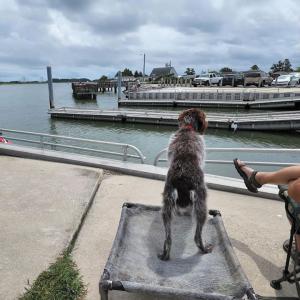Surf fishing is good this time of year
The summer grind is slowing down and schools are back in session, or about to be for some. Hints of fall are all around us; some leaves are starting to turn and drop. My gardens are down to late summer melons, and I am planting for the fall into winter. At this point I am just composting extra zucchini, making dirt.
Speckled trout have been around the Lewes Canal and inland bays for a bit. Unlike weakfish, these don’t have a creel limit, but like sheepshead, they are probably a fish we should put some limits on. Fish without limits tend to get the most pressure. It goes unnoticed until those species start to dry up, and then everyone takes notice - like weakfish. Why do you think there is a slot limit of flounder in New Jersey now? It isn’t because the fish stocks are doing well.
Sheepshead have been abundant around the inland bays and inlets, as well as the rock walls and reefs offshore. Sheepshead love fleas, or any crab. The rig is simple. Use a 2-ounce bell sinker or bank sinker and a leader or snelled hook. An octopus baitholder hook is preferred in the number one- to two-aught sizes. The barbs on the shaft help keep the bait in place. I, of course, use DS Custom Tackle snelled hooks. Drop the rig to the bottom near the structure and see what you produce. Triggers feed the same way and can be found along the same structure.
Structures come in many forms. Essentially it is anything that can allow life to grow on it, and or creates water movement. All structures have different features that affect that “reef” growth and water movement, and learning to read those features helps. Which way does the water move or flow off the structure? That is the “rip.” Larger fish will sit near or outside of a rip waiting for bait fish to come through and ambush them. Even larger fish will hunt those areas, looking for fish feeding on smaller fish. The food chain in the ocean is a violent environment. All structures can hold fish, but not all structures have fish at that moment.
The surf fishing has been productive even on busy weekends, before the crowds get heavy. There have been a lot of spot, some croaker, weakfish, and the usual summer suspects. Pompano is still far and few between. The problem with pompano is you have to target them, and it is not easy. The glowing sand flea bullet floats on the DS Custom Tackle pompano rigs are perfect for targeting pomps, as are the other colorful pill and bullet floats. Pompano like sand fleas, small crabs, and coquina clams. The colorful float patterns mimic all these colors, which will definitely increase your odds, especially in the north. Also, keep in mind pompano are a schooling fish, so where there is one there are many. Such a delicious fish, too.
Flounder action has been decent. The inland bays are still seeing some catches as well as the Cape Henlopen Fishing Pier. Offshore action has been much better than inshore. Jigging for them in the surf has produced. Flounder are abundant in the surf this time of year, and they are feeding heavier for their migration offshore in the winter. Flounder migrate offshore, not north and south. They just go out to deep water and come back in the spring, basically.
There have been a lot of angel sharks caught this year from the surf, more so than I have ever seen. These are federally protected, so please be careful handling and releasing. They look like a skate that ran into a shark.
There have been more shark anglers this year than ever at the beaches, and many need to learn the rules and good techniques for catching sharks. It is up to the angler to know and follow all fishery laws.
White perch catches are heavy along the Delaware Bay beaches. There’s also a lot of spot and croaker in the mix too.





















































